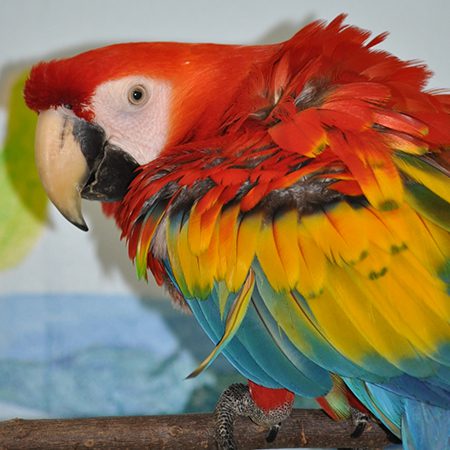Scarlet Macaw
Ara macao
Scarlet Macaws are a well known bird from South America. They have many vibrant colors that make them a charming and recognizable species. Their feathers are mainly red on their head, body, and tail. There is a large yellow band on their secondary feathers with their primaries (outermost wing feathers) being blue. Their faces are mainly white and featherless; their beak, which is white on top and black on the bottom, is outlined by a black strip. They are large birds, growing to almost 3 ft in length, about half of which is their tail. Despite their large size, they still weigh less than 3 lbs. Their average lifespan is about 30 years in the wild, but can be up to 75 in captivity.
They are a monogamous species, meaning they mate for life with just one other macaw. They are dutiful parents as well, and will take care of their young for up to two years until they can finally be independent. Like other macaws, they are herbivores, and mainly eat fruits and nuts. Macaws are also known for their ability to eat clay to aid with digestion of unripe fruit.

Scarlet Macaws are native to Central and South America, ranging across parts of Mexico, Panama, Chile, and Brazil.
HABITAT -They live in the rainforests of South America, preferring the tops of the canopy.
DIET -They eat primarily food and nuts with nectar and flowers as supplements.
FUN FACT -They show foot preferential just like humans, usually using the right foot to support themselves.
SOCIAL BEHAVIOR -They live in large flocks and will bond for life with one other macaw.
ACTIVITY -They are diurnal, being active in the day and sleeping in hollow trees at night.
PREDATORS -Adults have few predators, but juveniles are predated by snakes, monkeys, and small carnivores.
SIZE -They grow to be about 3 ft in length, including their tail.
RELATIVES -They are related to other macaws, such as the Spitz or Blue-and-Gold.
CONSERVATION -They are currently of Least Concern, but are experiencing heavy habitat destruction.

